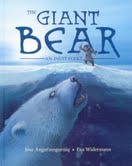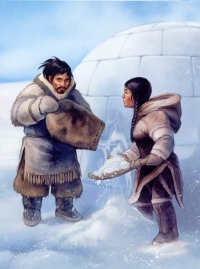| ________________
CM . . .
. Volume XIX Number 10. . . .November 9, 2012
excerpt:
Nunavut author and storyteller Jose Angutinngurniq shares this action-packed story found in The Giant Bear. The story was first told to him by his grandfather Alakannuaq, but Jose Angutinnqurniq has chosen to publish this story and share it with the world. The story begins by the sea where a husband and wife reside. One day, while the husband is hunting for food, he stumbles across an agul of a nanurluk. Realizing the opportunity posed by the sleeping bear, the hunter takes the water from the sea to narrow the nanurluk’s agul. He then returns to his iglu to protect his home and family. When all of the preparations are made, the hunter treks back to the aglu, wakes the bear, and prepares for the battle. Aggravated upon waking, the nanurluk tries to attack the hunter, but it soon realizes that the agul is too small to pass though. The nanurluk claws at the hole, expanding it to escape. As the great bear peaks through the ice, the hunter harpoons the nanurluk in the eyes and nose, rendering these two senses useless. As the great bear continues to heave its way out of the ice, the hunter continues to stab it. Eventually the nanurluk escapes the icy chasm, but it is so badly wounded that it stumbles across the ice, not even noticing the hunter. The bear collapses on the land, with the hunter trailing behind to collect the meat for food. Because of the hunter’s ingenuity and bravery, his family grew and prospered. In addition to sharing this remarkable tale, the book offers a much appreciated pronunciation guide. Located at the beginning of the story, the anglicized translations and definitions of the traditional words prove a most valuable feature when reading this story aloud to children. The accompanying manga-like illustrations by Eva Widermann effectively capture the mood of the story. The water colour background is soothing and serene, contrasting the dramatic and occasionally gruesome action at the forefront. The illustrations bring to life the scale of this drama, highlighting the epic nature of this folktale. I would recommend The Giant Bear for children ages 7-10. This story is full of action and suspense, with illustrations that enhance the narrative. Recommended. Rachel Yaroshuk is a Master of Library and Information Studies student at the University of British Columbia, Vancouver, BC.
To comment
on this title or this review, send mail to cm@umanitoba.ca.
Copyright © the Manitoba Library Association. Reproduction for personal
use is permitted only if this copyright notice is maintained. Any
other reproduction is prohibited without permission.
NEXT REVIEW |
TABLE OF CONTENTS FOR THIS ISSUE
- November 9, 2012.
AUTHORS |
TITLES |
MEDIA REVIEWS |
PROFILES |
BACK ISSUES |
SEARCH |
CMARCHIVE |
HOME |

